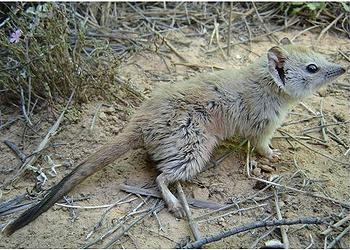
SYDNEY, Australia, December 28, 2017 (ENS) – A small carnivorous marsupial presumed extinct in New South Wales for more than century, has been discovered in Sturt National Park in eastern Australia.
The Crest-tailed Mulgara, a mammal known only from fossilized bone fragments, was once widely distributed across the inland sandy deserts of the island continent.
A research team from the University of New South Wales – Sydney’s Wild Deserts project made the discovery during recent scientific monitoring of Sturt National Park, northwest of the town of Tibooburra.

Wild Deserts is a new partnership between the University of New South Wales and Ecological Horizons, in collaboration with Taronga Conservation Society Australia and the Office of Environment and Heritage, with the goal of understanding, restoring and promoting desert ecosystems.
The project aims to bring back seven locally extinct mammals to the New South Wales corner country, the area in the extreme far northwest of the state, bound by the Queensland border to the north and the South Australian border to the west.
This outback area of diverse landscapes is divided by the rugged Barrier and Grey Ranges. It is an area of rich Aboriginal heritage, of stories of European explorers such as Captain Charles Napier Sturt, after whom the national park is named.
Using large fenced exclosures and innovative predator control and research techniques in Sturt National Park, Wild Deserts will exclude feral predators and herbivores such as cats, foxes and rabbits, before reintroducing mammals that were once widespread in New South Wales but have not been seen for over a century.
UNSW scientist and Wild Deserts ecologist Dr. Rebecca West says it’s exciting to find a Crest-tailed Mulgara alive for the first time in New South Wales.
“The Crest-tailed Mulgara was once widely distributed across sandy desert environments in inland Australia, but declined due to the effects of rabbits, cats and foxes,” West says.

“The species weighs around 150 grams (5.29 ounces) and has pale blonde fur and a thick tail with a distinctive black crest.”
The discovery comes at a great time, says UNSW scientist and Wild Deserts project co-ordinator Reece Pedler.
“Next year we are due to begin introduced predator and rabbit eradication from a large area, which will no doubt help the Mulgara,” Pedler says.
Wild Deserts has been contracted by the NSW Office of Environment and Heritage to restore and promote desert ecosystems in Sturt National Park.
National Parks and Wildlife Service area manager Jaymie Norris says the Wild Deserts project is contributing to the New South Wales Government’s Saving our Species conservation program.
“The aim of this project is to return mammal species not seen in their natural habitat for over 90 years in Sturt National Park,” he says.
“Rabbits, cats and foxes will be eradicated from two 20-square-kilometre fenced exclosures in Sturt National Park, before locally extinct mammals are reintroduced,” said Norris.
“Reintroduced native mammal species will include Greater Bilby, Burrowing Bettong, Western Quoll and Western Barred Bandicoot,” he said.
Previous work in South Australia by Wild Deserts team members suggests that the Crest-tailed Mulgara has been recovering in numbers and expanding its range.
Reduced rabbit populations during the past 20 years due to release of rabbit calicivirus is thought to have benefited the species by leading to increases in ground cover.
Reductions in populations of introduced predators such as cats and foxes has also increased the numbers of small rodents for Mulgara to prey on.
In recent years, Crest-tailed Mulgara have expanded their population in the Strzelecki Desert over the border in the neighboring state of South Australia.
Copyright Environment News Service (ENS) 2017. All rights reserved.
